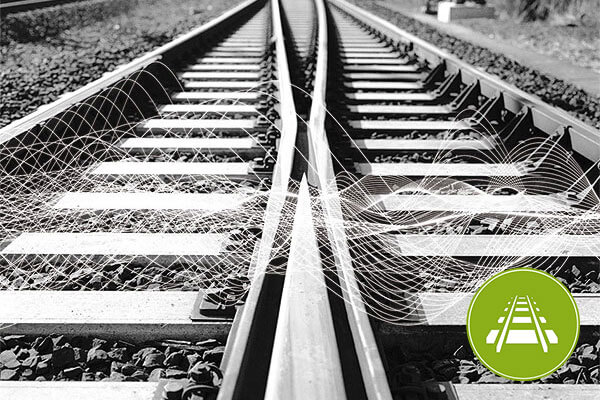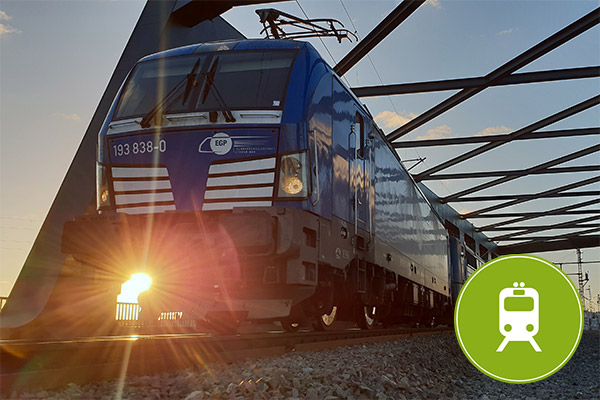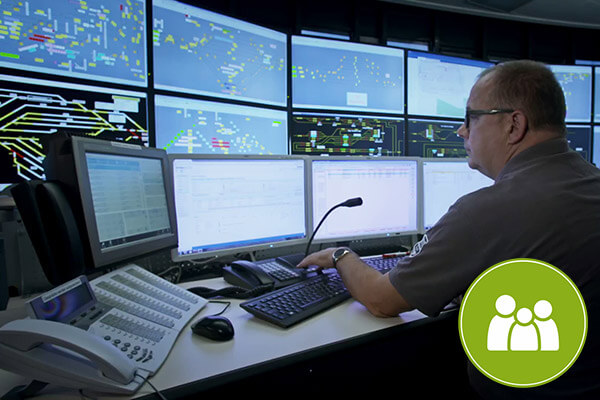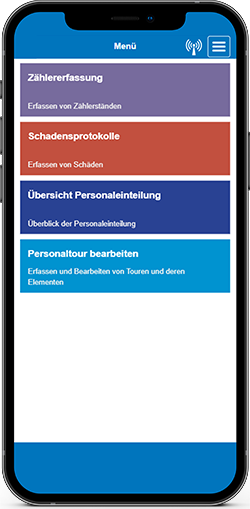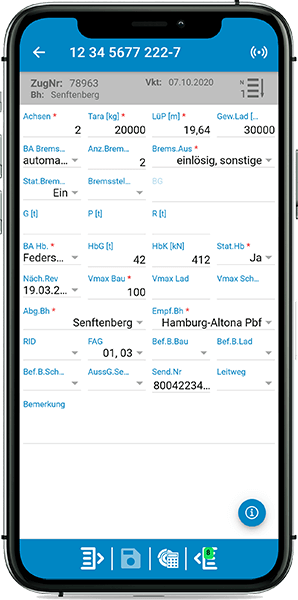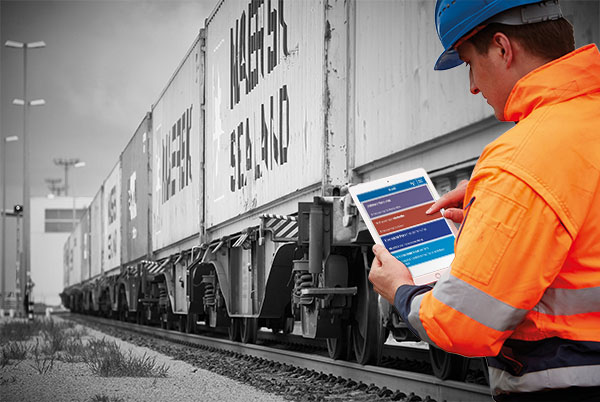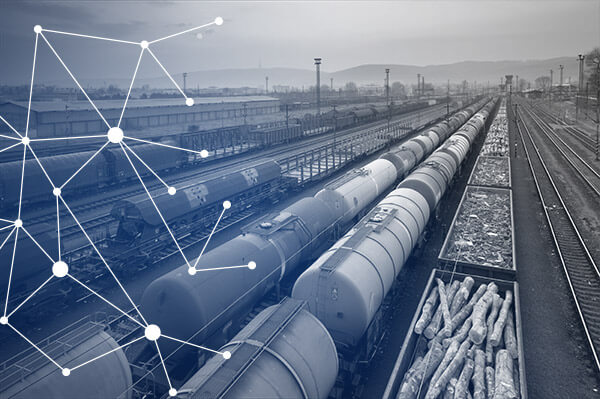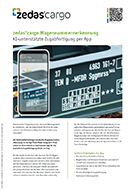
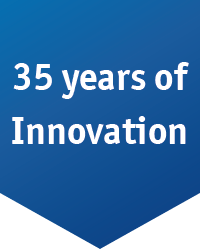

zedas®cargo
ERP-Software for the logistics management of rail freight transport
zedas®cargo is the integrated standard solution for logistics management in rail freight transport (RFT). The system integrates all actors inside and outside the company and digitally maps the typical processes along the value chain: commercial processing (order to cash), planning and operational management as well as controlling. zedas®cargo is suitable for all railway undertakings (RUs) that are active in block train traffic or in intermodal traffic / combined transport.
Eine Auswahl unserer Kunden
Use the potential of integrated railway production!
Integrated resource and order management
Efficient planning of all resources (personnel, locomotives, routes)
Automated communication with customers and partners
Broad interface landscape according to international standard (TSI TAF)
Modern apps for train control and duty roster
Support of the safety management system of the Railway Operations Manager
Key figures for well-founded management decisions
Check profitability of orders and identify weaknesses
zedas®cargo: One system for all parties involved
With the ERP-software for long-haul traffic from ZEDAS, you are opting for an efficient and economical solution that supports you in answering the most common questions of railway undertakings:
- How can I easily and efficiently schedule personnel and locomotives?
- How do I react quickly to deviations from the plan?
- How can I reliably provide my customers and partners with information?
- How can I invoice services completely and quickly?
- How can I comply with the future mandatory TSI TAF standards for data communication without much effort?
Integrated processes in the logistics management of long-haul transports
zedas®cargo combines the classic functions of logistics management with innovative enhancements – based on industry knowledge from the railway industry. The system is transport order management software, planning software and dispatching software in one. Using innovative technologies, we turn big data into smart data.
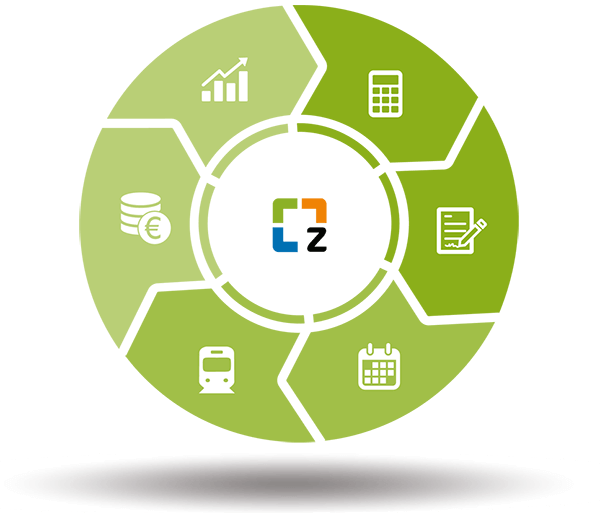
All service components of train transports are calculated in zedas®cargo. As a result, it is possible to quickly develop and compare costing variants and to create attractive offers in this way.
In the solution, all contract and order information are managed and made available for further steps. All factors, such as production scheme, delivery quantities and quality targets, are considered. Agreed rules for the distribution of messages and documents are stored. The automatic messages, e.g. on wagon provision, train departure or delays, optimise the customer experience.
The system optimally supports employees in planning and dispatching in the preparation of regular and ad-hoc transports. They quickly obtain an overview of the utilization of resources. The software automatically checks working time rules, collective agreements as well as employee qualifications and authorizations. Balanced planning ensures that the available resources are optimally utilized and efficient operations management is guaranteed.
Using the central graphical overview, the operations management is always aware of the current order and train running situation. The operations management is supported in the processing, monitoring and documentation of train services. Displayed plan-actual deviations enable prompt corrective measures. Train information is available to customers and partners in real time on request. Mobile apps support employees on the train in preparing the train, managing damaged wagons or recording actual working times.
The actual data collected in the operation is automatically posted in the orders and transferred to the billing. Invoicing to customers and partners is transparent and fast. Automatically managed personnel time accounts significantly simplify payroll accounting. Via interfaces, prepared data can be transferred to external systems.
zedas®cargo is a powerful tool for the identification of cost drivers and improvement potential along the entire value chain. All data for target vs. actual comparisons, post-calculations, statistics and key figures are available automatically and immediately after service provision.
Planning and scheduling in RFT: efficient, flexible, simple
With zedas®cargo, the planning of orders and the allocation of resources for regular train services is just as easy as for ad-hoc transports. The staff in planning and in the control center benefits from numerous features:
- Clear Gantt charts with views for routes, personnel, locomotives and transport orders
- Simple resource allocation via drag & drop
- Multiple, time-based planning levels: Annual planning (if required), weekly planning, daily planning.
- Automatic display of planning conflicts
- Quick overview of planned and unplanned services
- Display of free capacities
- Immediate display of changes in all views
- Automatically updated plan vs. actual comparisons
- Smart filter functions
Route planning
All operational and technical data of the train route are available in zedas®cargo. Timetables are imported automatically via interfaces to infrastructure providers. Changes in the timetable, e.g. triggered by road works, also end up automatically in the system. The data flows directly into order and resource planning.
Locomotive planning
Locomotive planning is based on order services, which are linked to rotations via drag & drop. Time and location conflicts are displayed within the planning. This also applies to locomotives that are not available due to maintenance activities, rentals, etc.
The mileage data for locomotives resulting from the timetable are transmitted to owners and entities in charge of maintenance (ECM). For wagons the data transmission takes place as Wagon Performance Message in TAF standard.
Personnel planning
Based on the orders, the system generates personnel requirements and demands. The shifts or tours are composed of different planning elements (travel time, setup / disassembly times, duty travel, breaks, office hours, etc.). During planning, the software checks applicable regulations, such as working time and collective agreement regulations.
When an employee is subsequently assigned to a shift, the software checks his or her suitability, such as fitness and qualifications (driver's license, additional certificates, type series knowledge, route knowledge). The software reports any conflicts that arise. The system also includes absence management and indicates when employees are not available for planning due to vacation, illness or parental leave.
Seamless collaboration via the zedas®cargo web platform
The Rail Hub is a central data hub within zedas®cargo that enables professional interaction between the RU, its customers and partners.
All actors are directly integrated into the process and information chain. All parties involved have the opportunity to make transport more effective, increase transparency and reduce throughput times.

Transport orders are recorded, coordinated and released electronically in the Rail Hub customer portal. Each partner receives the information that is important for him or her in a clear form. Customers of the railway undertaking enter their wagon data or wagon sets (wagons, containers, goods, hazardous goods) for the booking orders. They make bookings directly in the system or use the upload function of Excel files. The manual transfer of data from the customer is no longer necessary. The order information is directly and completely in the system – this saves the railway undertaking a lot of time.
ETA stands for the estimated time of arrival of customer shipments. With the automated ETA calculation for rail freight transport, customers are informed in an uncomplicated manner and in real time about the location of the commissioned cargo.
For this purpose, the software combines planning data of the entire route and resource utilization with current train running data. The calculation based on intelligent algorithms is performed continuously and in real time. Disruptions in the operating sequence are immediately considered. The portal shows the status of trains and wagons, their GPS location and deviations from the planned location. zedas®cargo reliably forecasts the arrival time and delivery of the customer's order. Now the customer knows whether and to what extent his delivery will be delayed and can adjust subsequent logistics or services accordingly.
The option to configure notifications of delays via SMS or e-mail keeps the customer up to date even when he or she is not in the system. The mobile-optimized web interface allows the customer to personally set up the ETA message configurations (occasion, frequency, communication channels).
The Rail Hub makes communication between the control centre and train drivers as uncomplicated as possible. In the info portal, employees can view and download their duty roster. All information about the shift, i.e. which train and which route are to be driven, details about the shift partition in driving time, breaks, train control or office time, can be viewed.
In addition, employees always have an overview of their hours account. Plus or minus hours as well as vacation days can be viewed and checked at any time. Even route knowledge proofs are visible to the employee in order to organize a timely catch-up and to prevent the expiration of validity.
Mobile workplace for locomotive drivers and wagon masters
Mobile applications for tablets and smartphones are a modular component of zedas®cargo. They significantly simplify the flow of information and data in operations. Employees can perform their tasks on the train independently of the central control centre, promptly and consistently on the move. Mobile working minimizes time-consuming arrangements, manual records and associated sources of error.
Mobile recording and transmission of damage wagons
If employees detect a damaged wagon, this is immediately documented via the app. The report is transmitted as a TAF Wagon Damage Report (WDR) via the GCU Broker to the respective wagon keeper. This automation considerably simplifies the transmission of damage reports as part of the contractual obligations between the railway undertaking and the wagon keeper.
AI-supported train inspection via app
The zedas®cargo Train Check is an easy-to-use app for paperless train check-in directly on the train. If the camera is pointed at the wagon area with the UIC wagon number, the AI automatically recognises and analyses the text characters and checks the recognised UIC number. No further symbols such as QR or barcodes are necessary for this. Direct booking of the wagons in the app is also possible.
For each wagon, the system retrieves the technical wagon master data (via the GCU-Broker / TAF interface) and any existing commercial load data from the central database.
The system automatically determines the permissible braking weights and transport restrictions on the basis of the load data. Thus, wagon masters only confirm the data for the most part; the manual entry of wagon data is the exception. All changes are available in real time in the central zedas®cargo system.
Automated brake calculation and document generation
After completion of the train check, the app determines the possible brake positions and calculates the braking weights and braking hundredths of the train. In doing so, the software considers the requirements of the planned train routes, such as speed limits and specifications regarding the brake position, by means of stored rules. The automated calculation saves time and, above all, costs. The wagon list and braking slips can be called up at any time to meet documentation requirements. Thanks to the central data storage in zedas®cargo, train drivers also have the option of downloading the documents in the app – for a paperless driver's cab.
Duty roster for employees
The mobile web application allows locomotive and traction unit drivers to view their shift schedule and to log in and out of their shift. The control centre can see at any time who has logged in and is ready to work. Using the start and stop function, employees can easily and quickly document the actual working times for their shift components (travel time, office time, breaks, etc.). In addition, it is possible to record payroll-relevant special features (e.g. waiting times, train malfunctions) and additional services rendered directly on site. The data is automatically processed and subsequently flows into the order and payroll accounting.
Safety Management
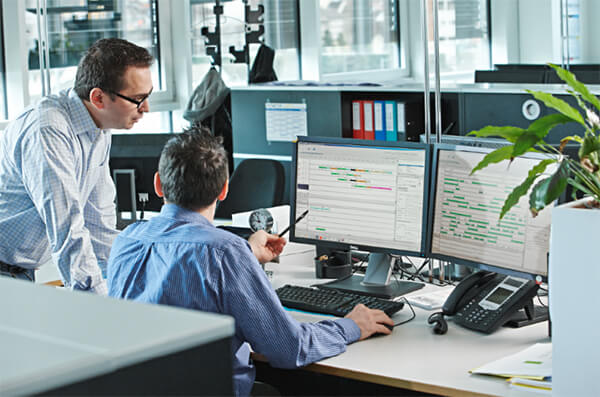
Railway undertakings must fulfil a large number of verification obligations within the safety management system. zedas®cargo offers railway operations managers a good basis for this. The software provides standard proofs simply at the click of a mouse. This includes, in particular, reports and documents for the personnel area, e.g. on duty periods, the status of qualifications and certificates as well as the acquisition or maintenance of route and local knowledge.
TSI TAF – for international rail operators
With the technical specifications for interoperability (TSI), the European Union defines Europe-wide standards for interoperable data communication in rail transport. zedas®cargo already has interfaces based on the TAF TSI standard since 2012. In coordination with our customers and depending on the current and upcoming regulations, we are constantly expanding this process. Communication according to the TAF TSI standard is essential, especially for internationally operating railway companies.
The following TAF TSI standard formats are supported by zedas®cargo:
- Train Running Information
- Train Delay Cause
- Rolling Stock Dataset (via GCU-Broker)
- Train Composition
- Wagon Performance (via GCU-Broker)
- Wagon Damage Report (via GCU-Broker)
- Consignment Order via ORFEUS (Raildata)
- in Release plan: Path Messages
Interfaces: Connection to third-party systems
In order to accelerate processes and minimize manual activities, we rely on a high degree of automation via suitable interfaces. With zedas®cargo we offer you both a large number of standard interfaces typical for railways (including EDIGES, EDIFACT, HERMES, TAF TSI) and the possibility of implementing specific individual interfaces on the basis of specialist concepts.
Typical examples:
- Timetable and train running data (various infrastructure managers)
- Train composition data (infrastructure manager, RU)
- Transport orders / consignment notes, shipment tracking, status messages (forwarders, shippers, RU)
- Personnel master data, payroll accounting (payroll accounting)
- Order settlement (accounting, financial accounting)
- Wagon master data (wagon keeper)
- Mileage data and damage wagon reports (wagon owner, asset and maintenance management)
- Data for internal / external service portals
- TAF interfaces
Book a software demo now!
Take the chance and book your software demo. Which functions are you interested in and which goals do you want to achieve with zedas®. We will be happy to help you and arrange a desired date with you.
Unique synergies in the rail industry
Lean processes through the combination of zedas®cargo and zedas®asset
ZEDAS provides the leading product suite for the seamless connection of logistics management of rail freight transport (zedas®cargo) with fleet and maintenance management (zedas®asset). The automated information flow significantly reduces the need for coordination between the areas.
The daily business of railway operations benefits from the increased availability and reliability of the vehicles. Rail production has access at all times to current information on the decommissioning / recommissioning of vehicles and on residual running values for deadlines. Transport tasks can be planned much more efficiently. Operations are less frequently impeded by waiting times or technically related disruptions.
Data on the individual rail vehicles obtained during the operating process is available for maintenance planning. The condition and load data, such as the mileage calculated from the timetable, as well as recorded damage and fault reports, enable reliable, load-dependent maintenance planning. Based on the comprehensive database, zedas®asset creates condition forecasts for the vehicles, which in turn form the basis for well-founded investment decisions.
Learn more about:
Fleet and maintenance management for railway vehicles
Asset and maintenance management for railway infrastructure
Logistics management for shunting traffic

5 strong reasons for zedas®cargo
| Our field of expertise: Logistics in rail freight transport We know the processes of the rail logistics management from our close cooperation with customers and from our experience being in the rail market for more than 30 years. |
|
|
Standard software – benefit from the knowledge of all |
|
|
One system – one truth |
|
|
Strong partner – everything from a single source |
|
|
A head start now and in the future |
More informationen




















